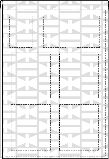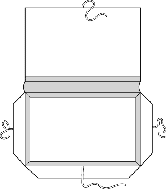3.3 Choosing furniture and equipment
3.3.1 Shelving
The resource centre will need shelves for books, reports and
pamphlet boxes. Adjustable shelves may be useful to accommodate
materials of different heights.
Shelves need to be:
- made from good materials
- strongly made
- supported approximately every metre to prevent sagging
- at least 20cm (8 inches) deep, 30-35cm (12-14 inches) apart
in height, with 10-20cm (4-8 inches) between the bottom shelf
and the floor to enable them to be cleaned, and to prevent
damage from flooding
- preferably without solid backs to allow maximum airflow
- preferably with a top shelf or cover to protect materials
if the roof leaks
- braced (strengthened) at the back
- not too high to allow people to reach the top shelf.
Different sizes of shelving units should be selected to suit
different spaces (such as low shelving units under windows and
higher units along walls, or free-standing units in aisles).
Shelving units can often be purchased ready-made. They come
in various sizes, with a varying number of shelves per unit,
in different colours and materials (wood or metal). Alternatively,
it might be possible to order shelves from a carpenter, which
would probably be less expensive and would provide local employment.
Book supports are useful to keep books upright when the shelf
is not full (see Section 5.5.1: Shelving materials). It is possible
to buy supports or make them from wood, or to use a bean bag
(cloth bag with beans or pebbles inside).
3.3.2 Display equipment
Different types of display equipment are useful for
displaying different materials.
Noticeboards, bulletin boards or pin boards
are useful for displaying information about forthcoming meetings,
new materials and so on, and for users to exchange information
about topics that they are interested in. At least one noticeboard
should be placed in the resource centre. Another noticeboard
should be placed outside the resource centre to catch the interest
of people passing by, and to show resource centre opening times.
Other noticeboards could be placed in other parts of the organisation,
such as the reception area, and outside meeting rooms or training
areas.
Slanting display shelves can be used to display
the latest periodicals received. Back issues of periodicals
can be stored underneath.
Wire racks, leaflet dispensers and hanging cloths
can be used to display leaflets, pamphlets, periodicals and
newsletters. They should only be used to display the most recently
received issues of periodicals or newsletters. Older issues
can be put in pamphlet boxes on the shelves.
TIP: How to make a hanging display
You can make a hanging display from cloth, for lightweight resource
materials such as leaflets or newsletters.
Take a piece of cloth about 240cm (8 feet) by 100cm (3 feet).
Turn under all the edges by about 2.5cm (1 inch). Fold the cloth
in two, bringing the shorter edges together. Sew across the
cloth about 5cm (2 inches) down from the fold, to make a space
to insert a pole. Sew along the other edges, to sew the two
folds of cloth together.
Mark places on the cloth to make pockets for leaflets or newsletters,
by laying leaflets or newsletters on the cloth and drawing round
them in chalk. Sew round the shapes, along the chalk lines.
Cut an opening across each shape about 8cm (3 inches) below
the top of the shape. Turn under and sew the edges to prevent
them from fraying.
Insert a wooden or metal pole in the space where the cloth
is folded. Attach some string to each end and hang up the cloth
on a hook.


3.3.3 Other furniture and equipment
The resource centre will also need:
- tables, chairs and desks for staff and users
- locked cupboards for video cassettes and other audiovisual
materials
- filing cabinets with suspended files for materials such
as small reports and papers, leaflets, pamphlets, press cuttings
and photographs
- pamphlet boxes for soft-cover materials, such as pamphlets,
leaflets, periodicals and newsletters
- plan chest, cardboard box or portfolio for large materials
such as drawings or posters
- communications equipment
- small items such as stationery.
Filing cabinets and pamphlet boxes can be used to store many
of the same types of materials. Filing cabinets are more useful
as it is easier to divide materials into clearly labelled groups,
whereas pamphlet boxes usually have to contain materials on several
topics to save space on the shelves. Filing cabinets also help
to keep materials free of dust.
A list of furniture and equipment is given in Section 3.3.4.
TIP: How to make a portfolio
Posters need to be stored flat. If you do not have enough room
or funds for a plan chest, you could make a designer’s
portfolio instead. You can stand the portfolio upright behind
a set of shelves or beside a filing cabinet.
To make a portfolio, take two pieces of hardboard or very strong
cardboard, a little larger than the largest poster to be stored.
Make a flexible hinge by sticking strong sticky tape, such as
gaffer tape, along one edge of each board, both sides.
Make flaps by attaching a narrow piece of card to each of the
other three sides of one of the boards. Attach some cord to
the outside edge of each of the two opposite flaps, and to the
outside edge of each of the boards.
Tie the cords on the flaps together to prevent the posters
from slipping out. Tie the other cords together to close the
portfolio.


3.3.4 List of furniture and equipment
This is a list of furniture and equipment that t
he resource centre is likely to need, including consumables
(items that will need to be replaced frequently). For more details
of computer equipment, see Section 6.
| Furniture |
Consumables |
Tables and chairs for users
Desks (or tables) and chairs for staff
Desk for computer and printer
Shelving
Slanting shelves for displaying periodicals
Filing
cabinet(s)
Wire racks for leaflets
Cupboard for TV and video
Card catelogue cabinet
Stool
Floor rugs |
Notebook for visitor
Notebook for record of borrowing
Notebook for statistics
Notebook for accountants
File folders
Record cards |
| Communications equipment |
Consumables |
Photocopier
Overhead projector
Slide projector
Television
Video
Computer
Uninterruptable power supply (UPS)
Printer
Telephone
|
Photocopier and toner
Overhead transparencies
Spare bulbs for both projectors
Diskettes
Anti-virus updates (every 1-3 months)
Printer ribbons and paper |
| Small equipment |
Consumables |
1 pair of sharp, medium-sized scissors
1 pencil sharpener
1 ruler
1 stapler
1 rubber stamp with name and address of resource centre
1 date stamp
1 ink pad
1 lockable petty cash box and keys
1 or 2 waste bins
At least 2 long, narrow boxes to hold record cards
|
Drawing pins
Pencils
Erasers (rubbers)
Staples
Ballpoint pens
Marker pens
Carbon paper
Ink for ink pad
Paper clips
Rubber bands
Black & white permanent ink
Plain white paper
Coloured paper for displays
Envelopes for mailing
Stamps
Masking tape
Sticky labels
Sticky tape
|
next: Section 4. Developing
the collection
top of page

